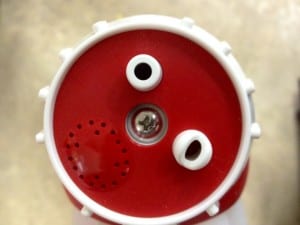I think it is safe to say that spring is actually here. How can we deny it when we see the blooms bursting free from tight pods, the birds chirping almost hysterically, and the pests happily chomping their way through the roots of our newly planted crops and fresh shoots of grass. Wait, what? It was all good up until that last part. But the truth is, we are not the only ones that look forward to the newness of growth that spring has to offer. You know the song, “Birds do it. Bees do it. Even educated fleas do it….”, and all the little pests of the garden do it too! This time of the year, larvae can run rampant in your garden, and they love nothing more than to wiggle their way into one of your crops and set up room and board. They may hang out, dwelling in your soil and gobbling up the roots of your plants and grass, while you don’t even know they are there until the damage is done. Or they lie in wait until they become adults and letting loose careening beetles that insatiably rip apart the fresh leaves of your crops. Oh woe to us, what is a hopeful gardener to do?
(Plant roots like these are irresistible to soil-dwelling pests.)
Enter the beneficial nematode, stage right. They may not seem much when you look at them. Actually, they won’t seem like anything when you look at them, because you won’t even be able to see them. Beneficial nematodes are microscopic round worms that kill the larvae and grub stage of insects, but are harmless to other organisms (no birds, or mammals will be harmed in the releasing of the nematodes).They can effectively control most turf insects and several other insects that live in soil. They work by entering a host and releasing bacteria into it. The bacteria develops in the host and the host dies from blood poisoning a few days later. The nematodes themselves develop by feeding upon the bacteria and degraded host tissue. They develop rapidly and thousands of nematodes can be produced following a single infection. The nematodes get released to move on to another host when the body wall of the dead host ruptures, usually within 2-3 days. And they continue reproducing and multiplying and soon you have an army of nematode invaders. Sounds a little like something out of a Stephen King novel, doesn’t it? Just enough awesome to balance out the gruesome.
(You can’t see ’em but they are there.)
Have I peaked your interest? I would think so. Here’s how you get them. Pop into one of our stores and grab yourself a sponge of nematodes. Yep, I said a sponge, and about 1 million nematodes are nestled inside it. These 1 million nematodes, will cover 2,000-3,000 square feet. That’s a whole lot of coverage for one tiny sponge! You’ll find them in the refrigerator at Rainbow Gardens and when you get home that’s where you need to place ’em and keep ’em when you get home until you are ready to release ’em. Make the nursery your last stop of the day so that you can get your nematodes home and store them in the coolness of your fridge, or use them right away.
(Yep, this is it….this tiny sponge holds all you need.)
“Release the kraken!” It’s best to release your nematodes in the morning or evening, when the sun is not blazing down. Turn an overcast or drizzly day into a great “nematode releasing” day. When you’ve found the perfect day to release your nematodes, you’ll want to make sure you have a few things on hand. You’ll need at a new gallon bucket, a hose end sprayer that has never been used to distribute pesticide or fungicide, or a rinsed out watering can (again never used for pesticides or fungicide…did I stress that enough?). The residue of pesticides in any container will kill your nematodes, so I prefer to have my sprayer and buckets set aside and labeled, “nematodes only”. Fill your bucket with water, submerge your sponge, squeeze the sponge under water for a few minutes to get those little buggers out of there, and then discard the sponge.
(Yikes! You do need a bucket, but for heaven’s sake, use a clean one!)
If you are releasing the nematodes on your lawn, pour some of the water from the bucket into a hose end sprayer, set the dial for the largest passage way so you get the biggest volume of nematodes streaming out, and saturate your lawn. Nematodes are swimmers, so it is a good idea to water your lawn before the release to encourage the nematodes to get down and dirty through the soil. A rainy day, or the day after is an ideal time to release them too. Your neighbors may think you are crazy watering in or right after the rain, but you will have the last laugh come grub season! If you are focusing on indoor plants (like issues with fungus gnat problems) or outdoor potted plants, water your plants first, and then mix your water with nematodes in a watering can so you can aim the nematodes where you want them to go. Here in San Antonio, you could apply the nematodes outside year round because our ground doesn’t freeze. But we suggest spring and fall as the best times to release them. Indoors and in greenhouses, you may find yourself needing to apply more often, every 6 weeks or so while the problems persist. It’s ok to fertilize your lawns before or after releasing nematodes, but applying any pesticide or fungicide, whether spray or granular will cause your nematodes to die too.
(Set this baby on the widest stream and let the nematodes hit the water slide!)
We love when there is something natural that works so great for some of our worst pest problems. Beneficial nematodes are just that thing. You won’t even be aware of all the carnage that is taking place beneath the soil surface, but you will be aware of the carnage that is not taking place above it. This is one of the most effective and easiest solutions to get to those hard to reach pests that plague us each year. Give these little swimmers a try, and I don’t think you’ll be disappointed.
(When offered the opportunity for a healthy lawn, free of troublesome, soil-dwelling pests, The Happy Gardener said, “Sign me up.”)
Lisa Mulroy







I’ve heard a second application is recommended in a week or two. Is that for different kinds of nematodes?
You really can’t overdo applying beneficial nematodes. When it comes to these little swimmers, the more the merrier. With the weather conditions we’ve currently had, and that are predicted this week, it is a great time to put them down!
Can beneficial nematodes be used on any type of grass? I have St. Augustine and want to use them for my lawn.
Hi Liz,
Yes nematodes can be used on any type of grass. They can even be used in containers. It’s the soil that they wiggle their way down into. The key to getting to where they need to be is a good watering. Follow the release instructions found on our benenficial insect page: https://www.rainbowgardens.biz/beneficial-insects/
How many indoor plants (both big and small) would you say one sponge covers approximately? Square feet is all I can find. I have about 400 indoor plants. Three sponges? One? Five?
Hi Mark,
One sponge should be sufficient. Water plants well before applying nematodes and after as well. One sponge, when released correctly, can cover those plants plenty.
I have mosquitoes will the nematodes take care of the mosquitoe problem that has developed in my yard??
Hi Mark,
No, the nematodes only control soil-dwelling pests. I would make sure you don’t have areas of standing water anywhere (water collecting in pots, old fountains, etc…) Mosquitoes lay eggs in areas like these and can increase their population greatly. Products like mosquito dunks can be applied in these areas if you can’t eliminate the water (the product is not harmful to wildlife). You can also use granules like Dr. T, and cedar granules, but they may have to applied again after the rain. The mosquitoes are bad this year.
Will the nematodes hurt live oak trees?
Not at all. Beneficial nematodes work on killing soil-dwelling pests.
Can nematodes eliminate fleas? ticks?
Hi Chele,
Nematodes work great for eliminating fleas and ticks in the yard. Keep in mind that **NEMATODES ONLY REMAIN EFFECTIVE IN THEIR PARASITIC STATE WHILE SOIL TEMPS ARE IN THE RANGE OF 42°F – 95°F.** Because of our hot temperatures in summer, nematodes aren’t always available in the nurseries during the summer. Look for them in the fall and spring time to apply and control/prevent fleas and ticks.
I have noticed termite damage at both ends of my house. Should I just distribute the nematodes all around the outside of my house? Would this be effective?
Beneficial nematodes can be a very effective treatment for control of termites. You can try thoroughly applying them to the soil along the foundation of your home and the surrounding areas. Using a hose-end type of sprayer can really help distribute the nematodes. Effectiveness could depend on how severe your infestation is, but generally, the nematodes take on the pests in the soil. Water nematodes in really well to make. Check for wood debris close to your home, leaking water fixtures, etc…things that attract termites.
Is this a good time to kill grub worms? I feel like my lawn has both grubs & a fungus. What do you suggest?
The best time to treat for grubs is around June. I’m attaching a link to our grub information so you can see how to check in your lawn to see if you currently have them, and will also attach info for our fungus guides. As far as a fungus, what are the signs you are seeing that indicate that? we need to know to differentiate among the different fungus issues that could be possible. Are you watering at night? That is one of the ways to develop fungus quickly in turf, so would suggest stopping that immediately if so. Can you take pictures of your lawn?, close up and panoramic so we can see? You can bring in samples to the nursery too so we can see it firsthand.
https://www.rainbowgardens.biz/news-events/grubs-lawn-pest-control-grub-grass-texas/
https://www.rainbowgardens.biz/news-events/lawn-fungus-prevention-treatment-guide/
Are beneficial nematodes harmful towards butterfly caterpillars?
Hi Ana,
No they are not harmful to butterfly caterpillars. Beneficial nematodes target soil-dwelling pests (under the soil). These are a great option for gardeners who would like to go the most organic route when it comes to pest control.
I bought 2 sponges and put in the fridge and forgot about them. How long do they last in the fridge?
Hi Christine,
Sponges of nematodes in the fridge have a shelf life of about 2 weeks. Nematodes in the yellow and green tub have a shelf life of about 9 months.
Is it too late to put out Nematodes? The fleas in my yard are out of control!
Hi Kim,
You would probably be best off to purchase a soil thermometer to know for sure. Soil temperatures in different landscapes vary due to many factors like: soil depth, sun exposure, soil type, and other things. Nematodes are viable when soil temps are around 42° – 95° so it gets a little iffy when our hot summer temps roll in. Hope this helps a little!
FYI They are about $52 as of 03/19/22 at Thousand Oaks Location.